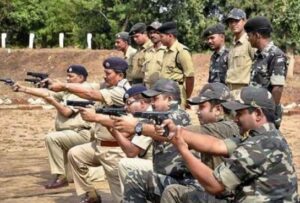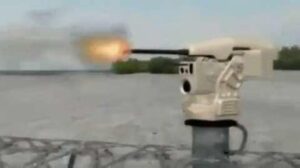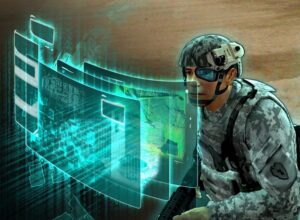THE EMERGING FUTURE OF FIREARMS IN LAW ENFORCEMENT
According to rough estimates, over 400 million firearms are in circulation globally, with India accounting for a significant percentage of this number. Police officers rely on firearms in their jobs, as they play an important role in law enforcement. Police officers use firearms for self-protection/defense, protecting suspects, or apprehending criminals. Firearms are also valuable for investigations, training exercises, and other uses. Law enforcement has used firearms for decades, with positive and negative effects. Law enforcement agencies use firearms to deter crime, maintain law and order, or fight armed gangs and terrorists. For the most part, firearms are a force multiplier. They allow an officer to be more lethal than they otherwise would be. However, they also carry the risk of unintended consequences.

Most firearms used by law enforcement today are semi-automatic rifles, which fire one round per trigger pull. In India, police officers at and above the SI or head constable rank carry a sidearm, generally a 9mm Pistol or a Glock 17. However, at the state level, Special units in India have automatic weapons, such as the AK-47, AKM, INSAS and Bren guns. And Special forces and SWAT units are equipped with Heckler & Koch MP5s, Brügger & Thomet MP9s, AK-103s, M4A1 Carbines and others. While semi-automatic rifles are incredibly accurate and reliable, they also tend to result in more collateral damage than a single-shot weapon (such as a revolver or shotgun). Semi-automatic rifles can also be difficult to reload quickly amid a gunfight, creating an additional tactical disadvantage for officers who may have to wait several seconds before being able to fire again after firing a gun in fully automatic mode. In that case, the rounds will continue firing until no more ammunition is left, which makes it even more difficult for officers to return fire accurately during a gunfight. Finally, semi-automatic rifles are unsuited for long-range engagement with targets that require precision shooting (such as snipers). On the other hand, some law enforcement agencies do not use firearms because they believe them to be too dangerous or impractical.

However, with more guns in circulation, keeping them all safe is more challenging, as firearms are not perfect devices. They can malfunction or misfire, most are heavy and bulky, some are expensive to maintain, some are easy targets for criminals and police tend to misuse them often by resorting to firing on innocent victims. These factors have led many police departments to consider alternatives which are less-lethal weapons like tasers and pepper spray. Others are experimenting with devices like body cameras and drones. Still, others have started exploring new technologies that could someday revolutionise how we handle guns in law enforcement. There are several different technologies available to law enforcement today.
WEAPONISATION OF FIREARMS WITH ARTIFICIAL INTELLIGENCE AND AUGMENTED REALITY
As the world progresses, so does the technology we use daily, which is also true for the firearms industry, which is always looking for ways to improve the efficiency and effectiveness of guns. The future of firearms technology in law enforcement is looking very exciting. New guns are under development incorporating AI and other cutting-edge technologies, such as augmented reality, allowing law enforcement officers to be better equipped and more effective in their jobs. One of the most promising new developments is using AI in firearms. AI is considered the third revolution in weaponisation; first, there was gunpowder, second nuclear weapons and now artificially intelligent weapons.The military is already using this technology in some countries, and it is now starting to be adopted by law enforcement agencies. AI-enabled guns can identify targets and even distinguish between friends and foes, which is a massive advantage in dangerous situations where every split-second counts.

However, there is a dystopian side to weaponising police weapons with AI . Weaponising weapons with AI means using AI to intentionally inflict harm on humans by integrating it into police or military weapons systems and tools. Creation of autonomous weapons using AI, which was once the realm of science fiction films like the “Terminator” series and “RoboCop,” killer robots, also technically known as Lethal Autonomous Weapons Systems (LAWS), have now been created and are being tested at an accelerated pace with little oversight, some prototypes have also got deployed in actual conflicts. So far, there are reports of Israel, Russia, South Korea, and Turkey’s militaries having weapons with autonomous capabilities. Countries like Australia, Britain, China, and the United States are reportedly investing heavily in developing Lethal Autonomous Weapons (LAWS) with an ever-expanding range of sizes and capacities. Slaughterbots, also called ‘lethal autonomous weapons systems or ‘killer robots, use Artificial Intelligence (AI) to identify, select, and kill human targets without human intervention. Police can enable autonomous systems to assess the situational context and decide on the required attack according to the processed information. Ultimately, LAWS could use AI technology to identify targets and kill innocent individuals. Besides, killer robots, like all technology, are vulnerable to hacking and could turn against their creators in the event of cyberattacks.

USE OF AUGMENTED REALITY IN FIREARMS
Another new technology under development for law enforcement firearms is augmented reality (A.R.). A.R. could provide officers with real-time information about their surroundings and help them identify potential threats. This technology can overlay information on the real world, such as the location of targets or potential threats. It is beneficial for law enforcement officers, as it gives them critical information that they can use to make split-second decisions. Additionally, AR could provide officers with guidance and instructions on delivering the best response in a given situation.The future of firearms technology is looking very bright, and it is clear that law enforcement agencies are taking advantage of the latest advances. We can consider this good news, as it means that we can expect law enforcement officers to be even more effective in their jobs in the future.

SMART GUNS
Another latest and positive trend in this industry is the development of smart guns equipped with networked technology that can keep people safe. Despite the concerns of some gun enthusiasts, smart guns have the potential to be a valuable tool for law enforcement agencies. In addition, using smart guns can help reduce the number of accidental shootings and the number of firearms that are stolen and used in crimes. While there are still some concerns about the safety and reliability of smart guns, it is clear that this technology has the potential to revolutionise the firearms industry. As more law enforcement agencies adopt these new guns, we will likely see a decrease in gun-related crimes and accidents.

A “smart gun” is a firearm that employs fingerprint sensors, radio frequency identification ( RFID), magnets, or biometrics to prevent anyone except the owner from firing the weapon. Some smart guns also incorporate a combination of grip style and the strength and size of the person’s hand to unlock the weapon. At the same time, some models allow the gun’s owner to enable other people to have access to the weapon (like the owner’s spouse, for example). One of the significant concerns among law enforcement over models that employ biometric technology like fingerprint scanning is that authentication doesn’t work 100 per cent of the time – as anyone with an iPhone can attest. All it takes is dirty or wet fingers/hands to lock a user out of their weapon. And, of course, you’re vulnerable to hackers when you introduce electronics into the equation. RFID, for example, can be hacked.
Privately owned or licensed gun owners could also safeguard their guns by installing intelligent chips in their weapons, which could determine whether the user is the current gun owner. The chip could also prevent kids from shooting themselves accidentally or other family members from committing suicide or make theft of the gun by thieves or Naxalites useless as they will never be able to use it. Cybersecurity will be critical when smart guns emerge in the Indian market to prevent hackers from breaching the system that monitors these devices. However, as the technology becomes more common, it will become easier to secure and protect the networks from hacking

This technology is a “no-brainer” for plainclothes cops as most officers in plainclothes don’t have safety holsters” if such an officer with a gun were hands-on with a suspect and the suspect got the officer’s gun. The officer wouldn’t have to worry about it because the person who grabbed the gun wouldn’t be able to use it against the officer or anyone. But even with the introduction of new, more LE-friendly models, there is also the question of whether putting untested technology into the hands of first responders who face uncertainty daily on the job is a good idea. But given the technology’s potential, it’s probably only a matter of time before a model that addresses the needs of police officers makes its way onto the market and departments, and investors get on board. Indian Police should take the lead in piloting the technology, as it would move our country in improving the safety of firearms and reduce accidental firing and deaths. But given the technology’s potential, it’s probably only a matter of time before a model that addresses the needs of police officers makes its way onto the market and departments, and investors get on board.

A SMART RIFLE THAT CAN AUTOMATICALLY AIM AND TURN ANYONE INTO A SHARP SHOOTER. (US ARMY)
Meanwhile, recently Kanpur-based Sri Hans Energy System Private Limited has developed a Kavach Smart Fingerprint Gun Holster for IOF.32 The Kavach holster has a biometric lock, so only the owner can retrieve the firearm placed inside the Kavach holster by using the impression of his fingerprint. The innovative holster uses a material similar to Kevlar, a polymer used to make bullet-proof vests.
Smart guns can help to improve the efficiency and accuracy of police forces. In a fast-paced and dangerous environment, every second counts and having a weapon that authorised personnel can easily and readily use can make all the difference. Moreover, smart guns can help create a safer working environment for police officers. By reducing the risk of accidental discharge, for example, officers can feel more confident and comfortable carrying out their duties. So, there are many good reasons why Indian Police should have access to smart guns. With the correct implementation, this technology has the potential to save lives and make a real difference in the fight against gun crime.
HELLADS
While smart handguns and rifles might be an incredible advance in firearms technology, they aren’t the only cool thing coming out of R&D these days, especially for military applications. There’s also HELLADS, which stands for High Energy Liquid Laser Area Defense System. It might not be the phasers or energy blasters we see in “Star Trek” or “Star Wars,” but we’re heading in the right direction. The goal is to create a high-energy laser system that is powerful enough to generate intense laser energy while weighing less than 5 kilograms per KW of power produced. It’s not a handheld phaser or blaster pistol, but we get to move away from projectiles as the primary ammunition for police weapons.
RAILGUNS
Once we start moving into outer space — How do we create a weapon you can use in the vacuum of space? Our current weapons and firearms lean on a contained blast to thrust a bullet forward. But there is no oxygen in outer space for the explosion to push the shot at the target. Researchers plan to bring rail guns to overcome the lack of oxygen in outer space. Railguns use solid projectiles similar to bullets. Still, instead of depending on explosions to propel them forward, they use electromagnets to create a potent magnetic field which will hurl the projectiles out at tremendous speeds, sometimes faster than Mach. Currently, available railguns are enormous and mounted on military vessels. Still, if we find our Space Force needing weapons in the vacuum of space, we may go ahead and develop handheld railguns.

A HANDHELD RAIL-GUN
Sandia has developed a self-guided bullet for small-calibre, smooth-bore firearms that could hit laser-designated targets at distances of more than a mile (about 2,000 meters with devastating accuracy. Conception and development of a self-guided bullet prototype by hunting enthusiasts Red Jones and Brian Kast and their associates took place at Sandia National labs, an R&D subsidiary of one of the world’s largest defence contractors, Lockheed Martin. The four-inch-long dartlike bullet holds an optical sensor that catches sight of a laser-designated target, triggering electromagnetic actuators in the bullet. These steer tiny fins that cut all spin and navigate the bullet to the mark with devastating precision. The creators expect that the production of these bullets could be inexpensive and rapid, making them potentially available to the military, law enforcement, and recreational shooters.

A SELF GUIDED BULLET
Merely 50 years back, much of the technology we take for granted today, from mobile phones to facial recognition technology, only existed in science fiction. But technology changes everything it touches, and that includes firearms. It might not be long before we have smart guns in our homes to keep us safe. Today we might not have handheld railguns, phasers or blaster pistols, but one thing is sure — we’re steering in that direction. The gadgets and devices we used to see in science-fiction movies have become real during the last few decades. With the technologies evolving exponentially, we may not be able to foresee how future firearms of the Police will pan out, but it will be exciting to wait and see.
 Dr. K.Jayanth Murali is an IPS Officer belonging to 1991 batch. He is borne on Tamil Nadu cadre. He lives with his family in Chennai, India. He is currently serving the Government of Tamil Nadu as Director General of Police, Idol Wing CID.
Dr. K.Jayanth Murali is an IPS Officer belonging to 1991 batch. He is borne on Tamil Nadu cadre. He lives with his family in Chennai, India. He is currently serving the Government of Tamil Nadu as Director General of Police, Idol Wing CID.
